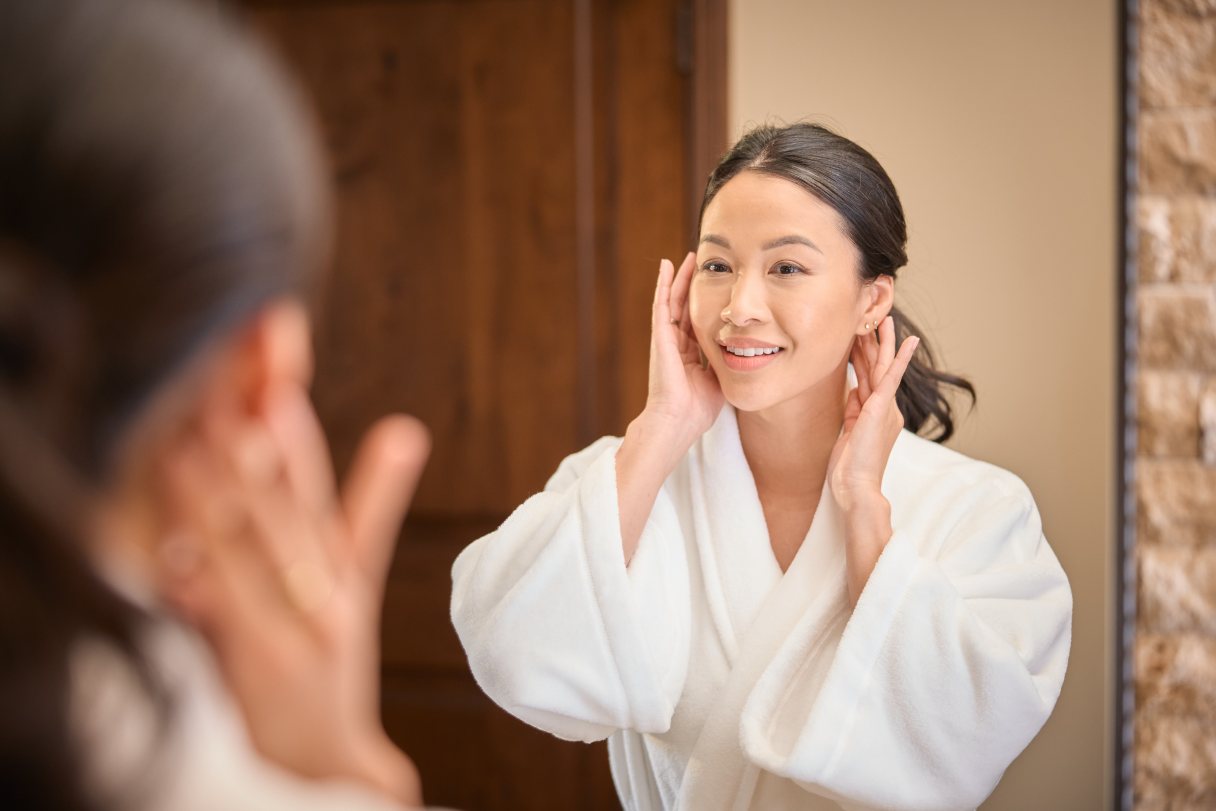Minimizing wrinkles, fine lines and scars is simpler than ever these days, thanks to skin treatments like light therapy. The non-invasive procedure can even help some medical skin conditions, like rosacea and eczema.1 But not all treatments are the same. There are a number of different types of phototherapy, ranging from mild LED (light-emitting diode) therapy to a more intense ultraviolet (UV) treatment.
This guide includes an overview of different light therapy options for skin conditions, how they work and who is a good candidate for each. Your dermatologist can help you decide which of these is the best choice for your unique situation.
What Is Light Therapy?
Light therapy is a term that encompasses a variety of non-invasive treatments that shine different spectrums of light on your skin to facilitate healing.1 UV light, for example, can help stop immune cells in your skin from overreacting.2 Meanwhile, LED treatments can reduce inflammation.1 Numerous conditions, ranging from cosmetic to medical, can be treated.1 And light therapy can be done on any part of the body.3 In fact, there are even devices you can use in the privacy of your own home.4
Types of Light Therapy
Different types of light therapy are available, and some cosmetic centers might even use some terms interchangeably. So it's always a good idea to ask your doctor exactly what type of light therapy they recommend for you. Here are the main types:
Red light therapy
Red light therapy is a common type of LED therapy. It does not use any UV rays. The red light stimulates fibroblast cells in your skin to produce more collagen, thus improving fine lines, wrinkles and the like.1
Some uses include:5
- Improving psoriasis, acne, rosacea and eczema6
- Improving wound healing
- Reducing fine lines and wrinkles1
- Reducing inflammation
- Stimulating collagen production
- Stimulating hair growth in alopecia cases6
Blue light therapy
Blue light therapy is another type of LED therapy that doesn't use UV rays.1 It's sometimes called photodynamic therapy when used with a sensitizing agent to help destroy abnormal cells while leaving other cells unharmed.3
Blue light therapy can treat conditions like:3
- Acne
- Precancerous and cancerous skin growths
- Psoriasis (mild cases on your arm or leg may even be treated with a wearable device at home)4
- Rosacea
- Sun damage and sun spots
UV phototherapy
UV phototherapy filters ultraviolet light to deliver the wavelengths that best treat your specific medical condition.7 It can help certain medical skin conditions by shutting down the activity of your skin's immune cells.2
UV phototherapy comes in different forms. Examples include:
- UVB phototherapy. This can treat medical conditions like psoriasis, vitiligo, dermatitis, lichen planus, allergic reactions, leukoderma and alopecia areata.8
- PUVA therapy. This combines UVA light therapy with an oral or topical medicine called psoralen.2
- UVA-1 therapy. This is a light therapy for skin conditions like scleroderma, morphea and cutaneous graft-versus-host disease.9
IPL (intense pulsed light) therapy
IPL therapy is sometimes confused with laser therapy, but it's different. Lasers use just one wavelength, but IPL heats the skin with a wide range of light wavelengths at once. It covers a greater area than laser therapy but with less concentrated light. The IPL device flashes light when it treats the skin.10
IPL can treat skin conditions like:10
- Acne discoloration
- Age spots
- Birthmarks or other vascular lesions
- Eczema5
- Psoriasis5
- Rosacea
- Sun damage
- Unwanted hair
How Much Is Light Therapy?
The national average cost* of light therapy can range from $43 to $243, depending on the type of treatment.11
Average cost of light therapy by type
Below are the average costs* and cost ranges of the different types of light therapy.11
| Type of light therapy | Average cost | Cost range |
|---|---|---|
| Red light therapy | $55 | $43 to $106 |
| Blue light therapy | $55 | $43 to $108 |
| UV phototherapy | $96 | $74 to $187 |
| IPL therapy | $126 | $98 to $243 |
Average cost of red and blue light therapy by state/district
Below is a breakdown of the average cost* of red light and blue light therapy by all 50 states and the District of Columbia.11
| State/District | Red light therapy average cost | Blue light therapy average cost |
|---|---|---|
| Alabama | $48 | $48 |
| Alaska | $67 | $67 |
| Arizona | $56 | $56 |
| Arkansas | $48 | $50 |
| California | $68 | $67 |
| Colorado | $56 | $56 |
| Connecticut | $59 | $60 |
| Delaware | $55 | $55 |
| District of Columbia | $65 | $68 |
| Florida | $55 | $55 |
| Georgia | $49 | $50 |
| Hawaii | $86 | $87 |
| Idaho | $56 | $56 |
| Illinois | $57 | $57 |
| Indiana | $49 | $50 |
| Iowa | $48 | $47 |
| Kansas | $50 | $50 |
| Kentucky | $51 | $51 |
| Louisiana | $50 | $51 |
| Maine | $55 | $55 |
| Maryland | $64 | $62 |
| Massachusetts | $64 | $62 |
| Michigan | $51 | $50 |
| Minnesota | $52 | $51 |
| Mississippi | $49 | $49 |
| Missouri | $49 | $50 |
| Montana | $54 | $54 |
| Nebraska | $50 | $49 |
| Nevada | $55 | $55 |
| New Hampshire | $59 | $58 |
| New Jersey | $63 | $63 |
| New Mexico | $50 | $50 |
| New York | $59 | $63 |
| North Carolina | $52 | $52 |
| North Dakota | $51 | $51 |
| Ohio | $52 | $52 |
| Oklahoma | $48 | $48 |
| Oregon | $59 | $60 |
| Pennsylvania | $54 | $53 |
| Rhode Island | $58 | $60 |
| South Carolina | $51 | $52 |
| South Dakota | $51 | $50 |
| Tennessee | $49 | $50 |
| Texas | $51 | $51 |
| Utah | $53 | $55 |
| Vermont | $57 | $56 |
| Virginia | $54 | $54 |
| Washington | $61 | $62 |
| West Virginia | $50 | $48 |
| Wisconsin | $52 | $52 |
| Wyoming | $52 | $51 |
Does Insurance Cover Light Therapy?
Your health insurance plan might cover light therapy, but only in cases where it's deemed medically necessary rather than cosmetic.12 For example, some health insurance providers may cover a UVB home treatment when it meets certain strict criteria, including being prescribed by a dermatologist, providing only UVB light and for specific conditions like psoriasis that are severe and extensive.13
In other words, you may need to meet a lot of qualifications to possibly get your treatment covered, so you may want to be prepared to pay the full price. Even with insurance, you often still have a deductible or other expenses to cover.
When determining how much you can afford, it's important to remember that light therapy can require multiple treatments. For example, blue light therapy for acne may require three to five treatments every two to four weeks.3
Who Is a Good Candidate for Light Therapy?
Your doctor can help you determine if you're a good candidate for a particular type of therapy, but here are some guidelines to help you get started:
- LED therapy can be used on any skin type. If you have a rash in a specific area, or if you use Accutane, you might not be a good candidate.1
- IPL therapy isn't a good choice for people with darker skin who may over-absorb the light.10
- UV phototherapy isn't recommended for anyone who has had skin cancer (or has a higher likelihood of developing it). It's also not recommended for anyone whose medication or medical condition makes them sensitive to UV light.14
What Happens During and After Light Therapy?
Light therapy varies depending on what type you're having done. In general, however, you can expect the preparation, procedure and recovery to look like this:
Preparation
Before starting your light therapy, you should know that you'll likely need multiple treatments to get the desired result, along with maintenance every now and then to maintain it.1 Your doctor may also recommend avoiding certain medications, depending on the type of treatment you're having.15
Other prep you'll need to do will depend on the treatment. For example, with IPL therapy, you'll need to avoid tanning and self-tanners for two weeks, and chemical peels, cosmetic injections and waxing for one week before treatment. You should not wear lotion on the day of the treatment.15
Procedure
Your procedure will look a little different depending on what type of treatment you choose. Here is a basic look at the main types:
- Red light LED therapy. This takes only about 10 to 30 minutes.6 You'll either lie down beneath the light or a small device like a mask or wand will target a specific area.1 You shouldn't experience any pain.1 In some cases, you might even be able to use a device at home and do the treatment yourself.5 Any LED therapy may require multiple treatments to get the results you need, sometimes as often as several times a week.6
- Basic blue light LED therapy. This may take only 30 minutes and works similarly to red light therapy.1 If you have a mild case of psoriasis on your arm or leg, you might even be able to just use a wearable device at home.4
- Photodynamic blue light therapy. This therapy is a bit more in-depth. Your doctor will first apply a photosensitizing agent to your skin so the area being treated is more susceptible to blue light. You'll wait (sometimes as long as a few hours) for the topical medicine to absorb into your skin. Then, blue light will be applied, and you may feel a mild tingling or burning.3
- UV therapy. You'll be asked to remove clothes that cover any part of your skin that needs treatment. You'll either stand in a booth to treat a larger section of your body at once, or a smaller unit will be used to treat a specific area. Treatments are typically just a few seconds to a few minutes in length, and your skin may feel slightly warm.2
- PUVA phototherapy. First, you'll take a form of psoralen medicine — usually in the form of pills or a bath — to make you more sensitive to the UVA treatment. You'll wait a specified amount of time (such as an hour after taking a pill) and then receive the UV treatment.14
- IPL therapy. Your doctor will likely clean the skin being treated and apply a cooling gel. You'll be given glasses to protect your eyes. Intense pulses of light that feel a bit like a bee sting will be applied for about 20 to 30 minutes.15
Recovery
Recovery times are fairly short for any form of light therapy.
- With basic LED therapy, there's no downtime.1
- If you get photodynamic blue light therapy, your skin will be sensitive at first and may look like you have a sunburn. This will go away in a few days to a week. You'll want to avoid bright light or sun exposure for at least 48 hours due to the photosensitizing medication.3
- With UV therapy, your skin will be slightly pink after treatment.14 You'll need to wear clothing and sunscreen when you're outside.2 If you had PUVA treatment, you're at an increased risk of sunburn.2 You'll also need to protect your eyes from the sun for the first 24 hours after treatment.2
- For IPL treatments, you may have some redness and discomfort, but it should only last an hour to a few days. You can apply a cold compress to soothe your skin as needed.15
Possible Side Effects of Light Therapy
The possible side effects can vary depending on the type of therapy you choose. For example, LED therapy carries very few potential side effects. You're not even likely to burn your skin.1
IPL therapy generally just brings redness for a few days at the most. Some rare side effects might include blistering, bruising or crusting.15
With UV phototherapy, which is typically used for medical conditions, the side effects are a bit more extensive and can include:14
- Blisters or burns (rarely)
- Darker spots on the skin (especially if you have a darker complexion)
- Early skin aging (such as wrinkles or age spots)
- Freckles
- Increased chance of skin cancer (less with narrow-band UVB treatment8)
- Mild stinging
- Sunburns
Light therapy is a relatively pain-free, non-invasive solution for cosmetic issues and some medical skin conditions. The treatment has relatively few side effects, and you may feel rejuvenated and refreshed afterward. Your doctor can advise you about which type of light therapy is best for your unique situation.
Financing Light Therapy With the CareCredit Credit Card
When getting light therapy or another cosmetic procedure, the CareCredit credit card can help you pay for costs not covered by insurance.** Use our Acceptance Locator to find a doctor or cosmetic specialist near you that accepts CareCredit. Continue your wellness journey by downloading the CareCredit Mobile App to manage your CareCredit account, find a provider on the go and easily access the Well U blog for more great articles, podcasts and videos.
In addition to cosmetic procedures, you can also use your CareCredit credit card for dentistry, pet care, vision, hearing, health systems, dermatology, pharmacy purchases, spa treatments and so much more within the CareCredit network. How will you invest in your health and wellness next?
Author Bio
Cathie Ericson is an Oregon-based freelance writer who covers personal finance, real estate and education, among other topics. Her work has appeared in a wide range of publications and websites, including U.S. News & World Report, MSN, Business Insider, Yahoo Finance, MarketWatch, Fast Company, Realtor.com and more.








